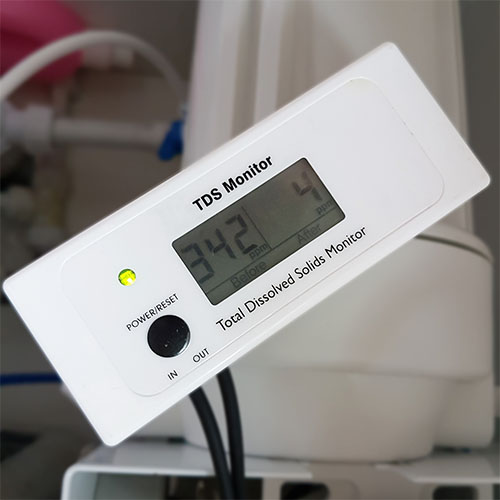TDS meters in focus
TDS meters are easy to order over the internet and seem to be a user-friendly tool to analyse water quality even for hobby chemists. How useful are they? And what exactly are they measuring?

What is being measured?
The TDS value (Total Dissolved Solids) gives the sum of dissolved solids in water. These solids include for example salts, minerals and metals. The value is also called the conductivity of the water. Because the more such solids or ions are in the water, the better it conducts electricity. TDS meters typically quantify this conductivity in microsiemens or ppm. The latter stands for parts per million, i.e. the number of solid particles per one million water mixture particles. A value of 40 ppm means that from one million particles there are 40 dissolved ions and the rest (= 999 960) are water molecules.
What does it tell about the water quality?
Anyone who assumes that water with a ppm value of zero, is automatically free from any pesticides and drug residues, is far from it. All the TDS meter measures, are merely the number of ions in the water. Most of the pesticides, hormone-disturbing substances and drug residues are usually no ions!
In short: a water with a low ppm value is virtually free from salts and minerals, but can hide a large cocktail of non-ionic chemicals in itself. The result of a TDS meter is therefore not very meaningful with regard to the actual water quality. Other analytical methods, or a water analysis by a reputable laboratory, may be better suited to find out about the real water quality.
Our recommendation
Unless you want to check the functionality of an osmosis system, the mere TDS values are not suitable as an indicator of the water quality. Since extensive and detailed water analyzes are often very expensive and only reflect a snapshot, they are only advisable if the drinking water is to be tested for individual substances. It often makes more sense to invest in a high quality water filter right away. This way you have more security with your daily drinking water consumption in the long term. However, it is essential to pay attention to appropriate assessments and long-term studies! Because the label "filters pesticides" can also mean, with an inferior filter, that only 5% of the pesticides are removed, or the retention rate drops rapidly after a short time.
